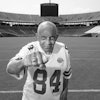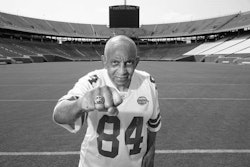Since Sam Bradford won the Heisman Trophy, the most prestigious individual honor in college football, earlier this month, Native Americans have been basking in the glow.
They see the talented quarterback, a registered Cherokee and finance major with a 3.95 GPA, as a significant role model for aspiring young athletes who share his heritage.
Bradford, who is from Oklahoma City, Oklahoma, is a sophomore quarterback at the University of Oklahoma and only the second sophomore ever to win the trophy that goes to the Most Outstanding College Football Player in the United States.
“Having an intelligent, well-spoken, poised Cherokee citizen play quarterback for the Sooners means a lot to Cherokee people all over the country, not just the ones here in Oklahoma,” says Chad Smith, the principal chief of the Cherokee Nation. “It means that people see a different image of Cherokees than the ones they may have had before, but it’s also a reflection to our community of the success we can achieve for ourselves and our families, our children and grandchildren.”
Smith adds that the chance to see “a Cherokee succeed at the highest level of college football, and to do it while keeping his GPA at 3.95, shows the values that we have always treasured in Cherokee society: education, selflessness and working together as part of a team or community.”
Although Bradford, 21, clearly identifies himself as Cherokee, including on his OU bio, he admitted in an interview with USA Today that he had not experienced a significant Native American influence or tradition in his upbringing.
“When people ask me questions about it, I have to be careful with how I answer,” he says in the paper’s article. “It’s something I’m definitely proud of, and I’ll never shy away from it. But I don’t know probably as much as I should know or as much as some people may think I know.”
By winning the trophy though, Bradford adds, “God has blessed me with a great platform. If I can use that in a positive way and be a role model for younger kids, set a good example for them, I think it’s a really good thing.”
James Sutteer, head football coach at Riverside Indian School, an Oklahoma boarding school for Native American students, agrees.
“A lot of times kids who are in a minority, especially a very small one like ours,” he says, may feel that “sometimes it’s pretty discouraging to go out on the field and stand around with a hundred players – especially in a public school – and look around and see, ‘Nobody looks like me.’”
“There are some outstanding Indian athletes that I think sometimes are overlooked or they don’t want to try because they’re the only one or one of a very few out of a large group of kids going out for a sport,” Sutteer adds.
Both Smith and Sutteer say they hope Bradford will immerse himself in Native American culture and spend time with young people in the community. If he becomes a tangible role model that they actually see in person and meet, they suggest, it could have an enormous impact.
“We’re trying to encourage our kids to use every opportunity they have to advance themselves,” Sutteer notes. “Everybody needs role models.”
This was the first year for Riverside’s football program, and it has already created a sense of enthusiasm in the school, which Bradford’s accomplishments have helped propel to a greater level.
“Football helps set the tone for the school year,” he says. “If we’re successful right off the bat, because we start the school year, then grades tend to be better. Behavior tends to be better. It seems to help everything along, and it seems to carry over into other sports.”
After his Heisman win was announced in New York City, Bradford made numerous media appearances. His final stop was on the floor of the New York Stock Exchange. He was given a tour and interviewed by CNBC financial reporters. The Tulsa World reported that even jaded traders stopped to shake his hand and snap a photo.
It makes one imagine the enthusiasm that would greet him at a Native American school.
“He’s a role model for a lot of our kids, not just on the field but in the classroom as well,” Smith says of Bradford. “He plays with passion, but he leads in a confident, poised, calm way. He plays with great sportsmanship. He encourages his teammates. Those are characteristics that are very respected in our community but are often downplayed in the dominant culture. His success validates those values.”
Email the editor: [email protected]
Click here to post and read comments
© Copyright 2005 by DiverseEducation.com















